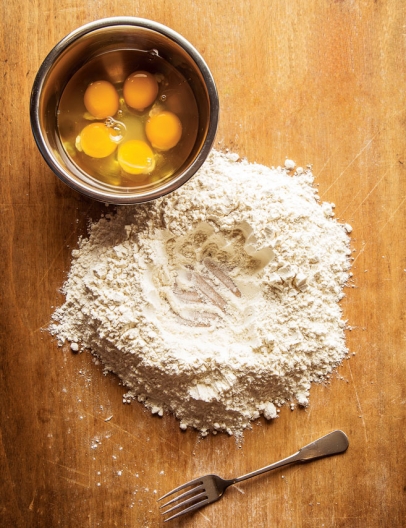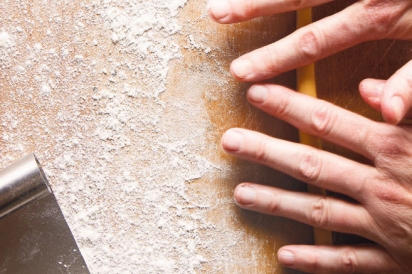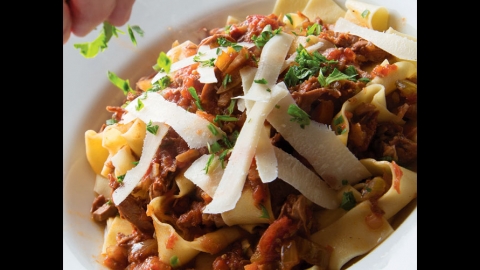Techniques & Ingredients: Fresh Pasta
Fresh Pasta
Thinking outside the pasta box
How often do we find ourselves craving a big bowl of comforting pasta? Whether it be spaghetti and meatballs, linguine with clams or a simple carbonara, hearty pasta never fails to satisfy. Making your own fresh pasta may seem like a time-consuming luxury, thanks to the toothy texture and lovingly handmade shapes, but in reality it comes together quite quickly.
But do a quick Google search for “fresh pasta” and you will be rewarded with hundreds, if not thousands, of possibilities: egg pasta, egg-free pasta, pasta with only egg yolks or egg whites, pasta made with all-purpose flour, semolina flour or 00 flour. And to salt or not to salt! When you finally settle on a recipe, the question is then posed whether to make long noodles, short noodles or noodles in some other shape. If that wasn’t complicated enough, there are as many shapes as there are regions in Italy. Sometimes it seems too daunting. Just take a deep breath and relax, for you probably have everything you need to make a fresh batch of delicious noodles in your kitchen: flour and eggs. With a few tips up your sleeve, a hearty bowl of pappardelle could be on the table by the time the dinner bell rings.
A few tips for successful pasta making:
● All-purpose flour works nicely in making just about any type of pasta, but there are a few other alternatives. 00 flour, with its powdery texture, yields silkier noodles. Semolina flour, made from Durum wheat, adds a heartiness and a rougher texture, which helps sauces cling better to noodles and shapes. Experiment with them all …
● Make the dough and for at least 30 minutes resist the urge to start rolling and shaping. Use this time to gather ingredients for a quick sauce, for the number one rule in cooking pasta is: The sauce waits for the pasta, the pasta never waits for the sauce. This waiting period also allows the gluten in the freshly formed dough to relax.
● It’s nice to have an extra set of hands to help you roll—this makes having a 6-year-old with nothing to do a big convenience. My son loves to help pull the dough through the pasta maker. He has also perfected the art of rolling up a sheet of freshly rolled pasta and cutting it into wide noodles that fall anywhere between wide pappardelle and linguine.
● There is no special equipment required for making fresh pasta—remember, Italian grandmothers have been doing this for centuries! However, a stand mixer can come in handy for mixing and kneading dough, and a pasta roller, either an attachment for said stand mixer or a countertop version, make rolling noodles immensely easier—and the result is much more consistent.
Making Fresh Egg Pasta
With just 2 ingredients—flour and eggs—you can be on your way to a hearty bowl of pasta. Salt is optional, but we like to include a pinch or 2 to bring out the dough’s flavor.
16 ounces (about 4 cups) all-purpose flour (or 2 cups all-purpose flour and 2 cups semolina or 00 flour)
Pinch or 2 of fine sea salt, optional
5 large eggs
Mound the flour in the center of your work surface or in a large bowl. Sprinkle with the salt, if desired. Make a well in the center of the flour and crack in the eggs.
Using a fork, beat the eggs together and then begin to incorporate the flour, starting with the inner rim of the well. As you expand the well, keep pushing the flour up to retain the well shape (do not worry if it looks messy.)
When half of the flour is incorporated, the dough will begin to come together. Start kneading the dough, using primarily the palms of your hands. Begin gently folding the dough on itself, flattening, and folding again. It will be extremely soft at first, then gradually start to firm up. Once it’s firm enough to knead, begin kneading the dough. Incorporate more flour as needed to prevent the dough from sticking to you or the counter. Once the dough is a cohesive mass, set the dough aside and scrape up and discard any dried bits of dough.
Continue kneading for 10 minutes, dusting the board with additional flour as necessary. The dough should be elastic and a little sticky. Wrap the dough in plastic wrap and allow to rest for 30 minutes at room temperature before using.
Alternatively, combine flour and eggs in the bowl of a food processor; process until the dough comes together. Run the processor for 5 minutes to start kneading the dough. Transfer the dough to a clean work surface, and knead 4 to 5 minutes. The dough should be soft and smooth and should not stick to your fingers when you pinch it. Cover the dough with plastic wrap, and let stand 30 minutes.
Note: At this point, the pasta dough can be refrigerated for up to 24 hours. Let it come back to room temperature before rolling.
Sprinkle a baking sheet generously with flour. Divide the dough into four equal portions and set them on the baking sheet. Dust the portions with flour and cover with a clean dish towel.
Note: The name of the game at this point is to keep everything well-floured to prevent the pasta from sticking to itself or the roller as you work. If the dough starts to feel sticky as you roll it, sprinkle it with flour. Also sprinkle flour on any pasta you’re not working with (rolled, cut or otherwise) and keep it covered with a dish towel.
To Roll Fresh Pasta
Attach a pasta machine to the top of a stand mixer or on the edge of a clean, long work surface. Flatten one portion of dough slightly with your hand and dust lightly with flour. Set the pasta machine to the thickest setting (usually marked 1) and feed one ball of dough into it four or five times in a row. Begin changing the settings on your roller (from 1 to 2 and so on), rolling the pasta two or three times at each setting. The pasta will become thinner and thinner with each increase in number. If the pasta cracks along the side, fold the cracked edge over and feed the sheet through the machine again to smooth it out. Adjust the machine to the thinnest possible setting and feed the dough through. The resulting sheet of pasta should be about 1/16 inch thick—just short of being translucent. Repeat with the remaining portions of dough.
If the strip of pasta you are rolling gets too long to handle efficiently, cut it in half and continue, working with each piece separately. Continue rolling until the pasta is as thin as necessary (you should be able to see the outline of your hand through the pasta: number 6 or 7 for linguine, fettuccine and other noodles; for stuffed pasta, 7 or 8.
Note: Italian grandmothers were making pasta long before KitchenAid invented their pasta attachment. To roll pasta by hand, use a well-floured rolling pin to roll the dough as thin as possible, lifting and moving the dough constantly to make sure it doesn’t stick to the work surface. Sprinkle the dough generously with flour and then gently roll it up. Slice cross-wise into equal-sized noodles. Shake out the coils, toss with flour and proceed with cooking.
Cutting Fresh Pasta into Noodles
Cut the long, rolled pieces of dough into noodle-length sheets, about 12 inches long. For making noodles, either switch from the pasta roller to the noodle cutter on your machine, running the pasta through the cutter, or cut them by hand: Hold 1 of the sheets above the board, then gently lay about 4 inches of the sheet flat on the board. Drape the sheet back and forth onto itself in a zigzag pattern. Slice the stack into noodles as wide as you like—1 inch for pappardelle, ¼ inch for tagliatelle, ⅛ inch for linguine. Toss the cut noodles with a little flour to keep them from sticking together and gather them gently on a floured baking sheet. Cover with a dish towel while you finish rolling and cutting the rest of the dough.
Cooking, Drying or Freezing Fresh Pasta
We prefer to cook the pasta immediately: Bring a large pot of water to a boil, generously salt the water, add the pasta and cook until al dente, 4–5 minutes.
To dry the pasta, drape the cut noodles over a clothes drying rack, coat hangers or the back of a chair (it’s time to get creative!) and let air-dry until completely brittle. Dry shaped pasta on a cooling rack set in a rimmed baking sheet until brittle. The dried pasta can be stored in an airtight container for several weeks. Freeze noodles or shapes on a baking sheet until completely frozen, then transfer to an airtight container or zip-top bag for up to three months. Dried and frozen noodles may need an extra minute or 2 to cook.
To Flavor fresh pasta …
Give your pasta a whole new personality by adding some of these flavorings to the dough.
Whole Wheat: Replace 4 ounces (about 1 cup) of the all-purpose flour with whole-wheat flour and make the dough as directed.
Beet: Roast 2 small beets at 425° until tender (about 1 hour). Peel, then transfer to a food processor and pulse until finely chopped. Add 4 large eggs and purée. Make the dough using this beet-egg mixture in place of the whole eggs.
Tomato: Add 2 tablespoons tomato paste to the eggs when making the pasta dough.
Spinach: Blanch 4 ounces stemmed baby spinach in a pan of simmering water until wilted. Drain and rinse with cold water then transfer to a kitchen towel and wring out any liquid. Transfer to a food processor and add 4 large eggs and puree. Make the dough using this spinach-egg mixture in place of the whole eggs.
Herb: Finely chop 4 cups fresh herbs (such as basil, chives, parsley, green onion or arugula) in a food processor. Add 4 eggs and purée until combined. Make the dough using this herbegg mixture in place of the whole eggs.











